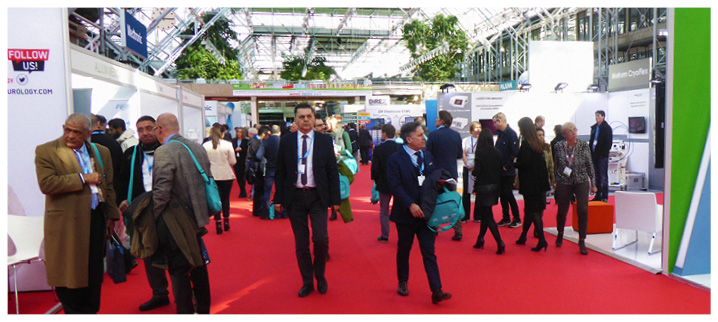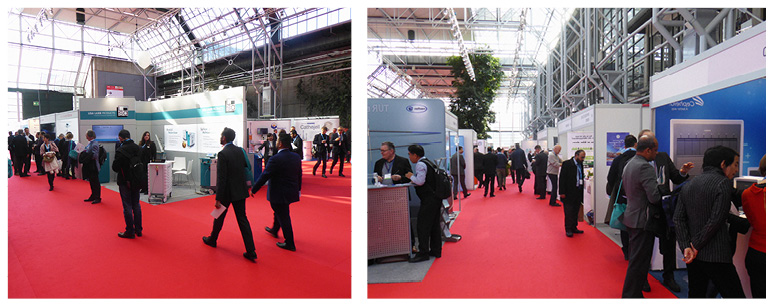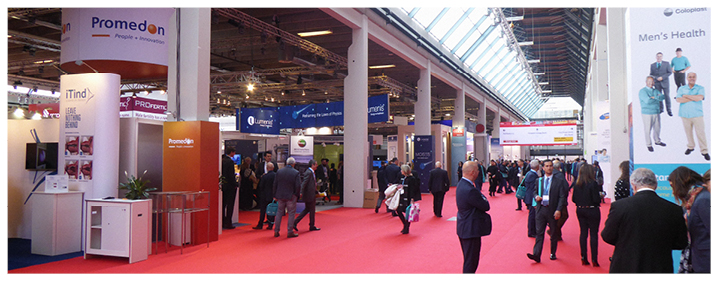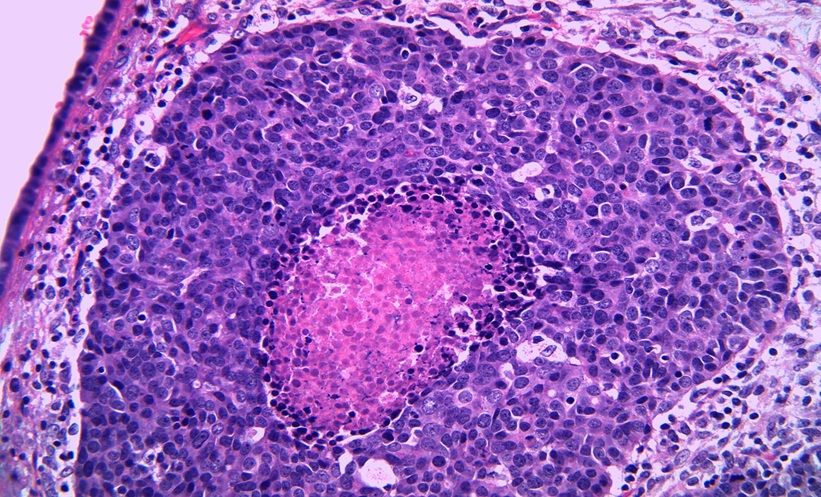March saw >10,000 members of the global urological community travel to the Danish capital Copenhagen to attend the Annual European Association of Urology (EAU) Congress, Europe’s largest urological event. The drumrolls of anticipation were literal as the opening ceremony was kicked off with a pulsating performance from the Copenhagen Drummers, who first hit the headlines with their triumph in the 2010 edition of Denmark’s Got Talent. When the thunderous applause had finally ceased, the EAU Secretary General, Prof Christopher Chapple, took to the stage and welcomed all attendees. He announced: “As you can see, the EAU meeting has grown every year and it is fantastic to see such an attendance. I bring you greetings from the Executive and Board of the EAU, and we warmly welcome you here, and it is through working with you that we are able to achieve what European urology has achieved in recent years.”
Indeed, the ability to leverage the diverse experience and knowledge of the medical professionals in attendance was a highlight of the scientific programme. There were numerous live surgery sessions, which enabled delegates to witness how particular procedures were carried out and learn more about specific aspects of a procedure that they might be finding difficult; these live surgery sessions also facilitated the consistency of standards across Europe and the globe. The debate sessions also offered not-to-be-missed opportunities; indeed, the EAU organising committee had made a special effort this year to increase the number and length of these sessions. The cut and thrust of the lively verbal sparring, debating key urological issues, enabled a vast number of ideas to be shared throughout the congress. Commenting on the debate sessions, Prof Arnulf Stenzl, Chair of the Scientific Congress Committee, enthusiastically explained: “[Medical professionals] can get a lot via video streaming, but these debates, sometimes even participating in that debate, that is something they can only do here, and that should be a good reason to come here in person.”
As ever at the EAU Congress, there were numerous awards bestowed. The EAU Frans Debruyne Lifetime Achievement Award was presented to Prof Didier Jacqmin by Prof Chapple, and the EAU Crystal Matula Award was awarded to Prof Selcuk Silay. First prize for a non-oncology-related abstract was presented to Chebbi et al. for their work, which concluded that conservative management should be considered an option for patients with renal trauma associated with urinary extravasation at the initial assessment with computed tomography (CT). The prize-winning urology-related abstract, authored by Birtle et al., was on the topic of post nephroureterectomy treatment for upper tract urothelial cancer. This year’s EAU Congress also saw the culmination of an exciting new competition: the EAU Guidelines Cup. As one might expect from the award’s title, this was a contest to crown the EAU member with the most comprehensive knowledge of the EAU Guidelines. By the time of the congress, 450 entrants had been whittled down to just 3. These 3 took to the stage to face off in one final quiz. When the dust had settled, Dr Dimitrios Deligiannis, ably supported by Team Greece, emerged victorious and claimed the top prize: free attendance at any of the masterclasses offered by the EAU.
Overall, the EAU Congress provided a urological experience par excellence, with countless opportunities to network, learn, and share ideas. The EMJ team was privileged to be part of this event, and we are very much looking forward to visiting Barcelona in 2019 for the 34th Annual EAU Congress!

A New Drug to Combat Kidney Stones
KIDNEY STONES affect 50–60 million Europeans, according to estimates made by the European Association of Urology (EAU). A new Japanese study, reported in a EAU press release dated 17th March 2018, has revealed that a β3-adrenergic receptor agonist, which regulates fat accumulation, prevents the formation of kidney stones in mice, offering a new avenue for treatment options.
Free fatty acids induce inflammation and other cytotoxic events that promote kidney stone formation. β3 agonists, commonly used in weight management therapies, trigger the conversion of white fat cells into beige fat cells that reduce the levels of free fatty acids. Therefore, it was hypothesised that, with the use of β3 agonists, the level of free fatty acids could be reduced and the formation of kidney stones prevented; these drugs will therefore offer an improved universal preventative therapy over the potassium-sodium citrate drugs currently used.
For 12 days, 20 experimental mice received daily intra-abdominal injections of the β3 agonist CL316243; control mice were injected with saline for the same time course. At Day 6 both populations were also initiated on daily injections with glyoxylate, an agent that promotes the formation of kidney stones. Kidney stone formation was shown to decrease to 17% in the experimental group, significantly lower than the control group (p=0.05). Analysis of the adipose tissue identified significant differences between the two gene expression profiles, including a 4.2-fold increase in adiponectin, a protein key to fatty acid breakdown, in the experimental mice.
Dr Teruaki Sugino, Graduate School of Medical Sciences, Nagoya City University, Nagoya City, Japan, commented on this proof-of-concept study: “I believe that this may open the way to the development of the new drugs which can stop the development of kidney stones in at-risk people.” The study cannot yet be directly translated into humans and requires further work in animal models to test tolerability and efficacy, but the use of β3 agonists to prevent kidney stones presents a new dawn in medical treatment.
Gender Reassignment Surgery Improves Quality of Life
One of the largest clinical surveys assessing the effect gender reassignment surgery has on quality of life (QoL) has shown a distinct improvement in general and trans-specific QoL after male-to-female reassignment surgery. According to a EAU press release dated 17th March 2018, the novel trans-specific Essen Transgender Quality of Life Inventory (ETLI) was shown to give the best assessment of QoL post reassignment surgery available to clinicians.
Generally, transgender people have a worse QoL than the non-transgender population, with elevated stress levels and mental illness. The presentation of ETLI at the 2018 EAU Congress is encouraging for both clinicians and the transgender community and presents the first available method to accurately assess wellbeing after surgery.
Dr Jochen Hess, University Hospital Essen, Essen, Germany, led the research team that followed 156 patients for >6 years after gender reassignment surgery and used the specifically designed ETLI to explicitly evaluate patient QoL. There are an estimated 1.4 million adults identifying as transgender in the USA, equating to roughly 0.6% of the population, which further emphasises the importance of being able to quantifiably evaluate the benefits of gender reassignment surgery.
The results of the study were largely positive, with 75.0% of participants reporting they experienced a strong enhancement of general life satisfaction, and 67.1% were satisfied with their physical appearance as a woman. Both optical and functional results were also encouraging, with 71.0% and 65.3% reporting to be (very) satisfied, respectively. Additionally, 76.2% of patients confirmed they were able to achieve orgasms.
Despite the high dropout rate, due in part to participants not being interested in taking part, Dr Hess was positive about the future impact of ETLI, commenting: “Nevertheless, we now have the first specific validated tool for measuring QoL in transgender patients, we hope that this means that we can go forward to gather better information to help us improve treatment.”

Call for Greater Focus on Psychological Care for Cancer Patients
CHANGES to the paradigm of urological cancer management have been suggested following the results of a study reported in a EAU press release dated 16th March 2018. The researchers reported that patients with urological cancer were significantly more likely to commit suicide than those individuals without cancer, suggesting that management of psychological stress should form an essential component of the management regimen for urological cancer.
It is already known that psychological stress affects cancer patients, with 5–25% of patients affected by depression; therefore, this study, the first major examination into suicidal intent in cancer patients, provides valuable information for urologists in designing management strategies.
The researchers conducted a retrospective analysis of all patients from England and Wales in the Hospital Episode Statistics database who had been diagnosed with cancer from April 2001–January 2011. The headline finding was that patients with urological cancers were 63% more likely than other cancer patients to commit suicide and 5-times more likely than individuals without cancer. The suicide incidence was 48 per 100,000 for patients with bladder cancer, 36 per 100,000 for patients with kidney cancer, and 52 per 100,000 for patients with prostate cancer. The results also highlighted that the urological cancer with the shortest median time to suicide, 175 days, was kidney cancer. No difference in suicide rates was found when results were adjusted for sex; however, those patients with kidney cancer aged <50 years were more likely to attempt suicide (p=0.01), and older patients with bladder and prostate cancer were more likely to attempt suicide (p<0.01). Further analyses showed that there was no association between the Charlson Comorbidity Index and suicide attempts in patients with prostate or bladder cancer.
The researchers wrote: “Formal identification of those at risk [of developing suicidal intentions] and early intervention should form the standard of care for patients diagnosed with urological cancers.” This work has revealed several management avenues to be considered. For instance, the difference in median time to suicide between cancers suggests that there may be times of particular psychological vulnerability for patients where intervention would be most efficacious.
Important PIVOT Trial Results do not Represent Real-World Patients
CONCLUSIONS drawn from the influential prostate cancer study PIVOT have had a major impact on clinical decision-making, both in the USA and worldwide. Now, a new analysis performed by researchers at the Henry Ford Hospital, Detroit, Michigan, USA, suggests that the subject group examined in PIVOT may not accurately reflect real-world patients.
PIVOT included 731 men with low, intermediate, or high-risk prostate cancer, for almost 20 years; these patients had a median prostate-specific antigen value of 7.8 ng/mL and were randomised to radical prostatectomy or observation. Results indicated that there was little difference in overall mortality in patients undergoing surgery compared to those managed through observation only, though the latter group did report more side effects.
However, a research team from Henry Ford Hospital used data from three USA cancer databases to assess whether PIVOT accurately reflected real-world patients; these registries were the Surveillance, Epidemiology, and End Results (SEER; a population-based registry with 60,089 men) during 2000–2004, the National Cancer Database (NCDB; a hospital-based registry with 63,303 men) during 2004–2005, and the 2,847 men diagnosed with prostate cancer in the PLCO trial between 1993 and 2001.
Results indicated that the patients studied in PIVOT were older and sicker than those found in the general population. The mean age of men at diagnosis in PIVOT was 67.0 years, compared to 65.8, 61.3, and 60.2 years in PLCO, SEER, and NCDB, respectively. Overall mortality in PIVOT was also higher: 64% over 12.7 years, compared to between 8% and 23% in the other databases over a similar timescale (7.5–12.3 years). “Our work shows that the PIVOT trial used a sample of patients who were not representative of the real population affected by prostate cancer,” explained Dr Firas Abdollah, Henry Ford Hosptial.
These results challenge the relevance of PIVOT and suggest that further studies are required before the relative benefits of intervention versus observation for prostate cancer can be properly defined. As Dr Abdollah summarised: “The direct clinical implication of the PIVOT study is that we should abandon surgery in virtually all prostate cancer patients and limit our management to observation. However, in most experts’ opinion, this would result in a significant increase in the number of men with metastatic prostate cancer, and in those who will succumb to the disease.”

Prostate Magnetic Resonance Imaging Reduces the Need for Invasive Prostate Biopsies
MAGNETIC RESONANCE IMAGING (MRI) scanning during prostate cancer diagnosis can be used to identify harmful prostate cancers that require treatment, preventing overdiagnosis. The PRECISION trial is the first international, multicentre, randomised trial to show such benefits of MRI in prostate cancer diagnosis, and the results were detailed in a EAU press release dated 19th March 2018.
With the aims of reducing the need for biopsy in patients with clinically insignificant disease and providing better diagnostic information than traditional transrectal ultrasound-guided prostate biopsy (TRUS), which can often miss tumours during the procedure, the PRECISION trial investigators performed MRI scans on suspected prostate cancer cases. A total of 500 men were allocated to have either a 10–12 core TRUS biopsy (n=248) or an initial MRI scan and then a biopsy only if an abnormality was found (n=252).
The team noted that clinically significant cancer (Gleason score ≥3+4) was detected in 38% of men in the MRI and biopsy group versus 26% of men who received only the TRUS biopsy, equating to an absolute difference of 11.7% after adjusting for centre effects (p=0.005). In addition, after initial scanning 28% of men in the MRI group were shown not to require a biopsy at all. “This shows that a diagnostic pathway with initial MRI assessment followed by biopsy when required, can not only reduce the overall number of biopsies performed, but can give more accurate results than TRUS biopsy alone,” commented Dr Veeru Kasivisvanathan, University College London, London, UK. The team also found that patients who had initial MRI screening experienced fewer side effects because the specific cancerous area was identified, meaning fewer biopsy cores were required.
For MRI to be considered part of the diagnostic process in prostate cancer, the researchers described the need for appropriate clinician training and an increased capacity to perform the screening. However, the significance of the results was reinforced by Prof Hein van Poppel, EAU Adjunct Secretary General, University Hospitals of the Leuven, Leuven, Belgium, who stated: “This work shows that using MRI to decide whether or not to perform biopsy has the potential to save around a quarter of a million European men each year from going through the biopsy procedure, and so may be cost-effective in the long run.”
Prostate Cancer Diagnosis via Artificial Intelligence
ARTIFICAL INTELLIGENCE has been shown to have a promising future in the diagnosis of prostate cancer, according to the results of a study reported in a EAU press release dated 16th March 2018. The researchers suggested that they have developed the first machine-based analysis system that can accurately diagnose prostate cancer. As prostate cancer is the most common cancer diagnosed in men globally, with approximately 1.1 million annual diagnoses, improvements to the diagnostic process are critical to improve patient outcomes.
The Chinese research team developed an analysis system that utilised machine learning. The system was ‘trained’ using 918 prostate whole mount pathology section samples obtained from 283 patients using robot-assisted laparoscopic radical prostatectomy. The 918 images were divided into 40,000 smaller samples, of which 30,000 were used to train the software via machine learning. To determine the accuracy of the system, the diagnosis made by a human pathologist was treated as the gold standard to which the system’s results for the remaining 10,000 samples were compared. This comparison found the system was able to make an accurate diagnosis in 99.38% of cases.
Furthermore, it appeared that the system was also able to accurately classify the malignancy of the cancer; initial comparisons have found that the system and a human pathologist attributed the samples with similar Gleason scores. However, the authors noted that their sample contained more Gleason score 3 and 4 compared to other grades and that this might have influenced the machine learning process. Researchers are considering suitably objective standards to enable validation of the system’s Gleason score analysis to further test and improve the software.
While discussing the future impact of this development in artificial intelligence, the study leader, Dr Hongqian Guo, Nanjing Drum Tower Hospital, Department of Urology, Nanjing, China, explained that an experienced human pathologist would be required to bear responsibility for the ultimate diagnosis, but concluded: “In the short term, this can offer a faster throughput, plus a greater consistency in cancer diagnosis from pathologist to pathologist, hospital to hospital, country to country.”

Quality of Life Results for Partners of Prostate Cancer Patients
Results from one of the first studies investigating how prostate cancer affects the partners of patients were presented in a EAU press release dated 19th March 2018. The results of this study indicated that role change, isolation, and the fear of losing a loved one were three key factors affecting the quality of life (QoL) of partners of prostate cancer patients.
To investigate the factors that affected the QoL of patients’ spouses and to identify how healthcare professionals can help reduce these burdens, a total of 56 women were questioned on how their partner’s cancer affected their lives. The study, led by registered nurse Ms Jeanne Avlastenok and Dr Peter Østergren, Herlev and Gentofte University Hospital, Herlev, Denmark, showed that nearly half (46%) of the 56 women reported that their partner’s health had impacted their own health.
Of the 56 women, 8 were randomly selected for further, in-depth, focussed-style interviews to ascertain how each woman was being affected by their partner’s illness. Ms Avlastenok explained: “We worked with the women as a group, encouraging them to be open about what they felt in a supportive, group environment.” She went on to elaborate: “Many felt increasingly socially isolated. Their husbands were fatigued both by the illness and by the treatment, which meant that they couldn’t socialise as a couple, which made the women feel cut off from social support.”
Many studies investigating how prostate cancer affects QoL focus on the impact on the patient, and the partner’s QoL is often overlooked and neglected. Results from the study highlighted three specific areas that spouses identified as key factors affecting their QoL: role change, isolation, and the fear of losing a loved one. Identifying these factors allowed the spouses to pinpoint tools that they would find helpful, including written materials on how to deal with emotional issues, what the expected disease course is, and how to prepare for losing a loved one. This study has allowed a better understanding of the effect advanced prostate cancer can have on a spouse’s QoL, hopefully allowing spouses of prostate cancer patients to feel more supported in the future.
The team highlighted that the focus group findings were very much qualitative work in a small sample population, but also emphasised why this study was so critical in the journey to better support relatives of seriously ill patients. Dr Østergren commented: “[…] In any study, you need to do the qualitative work before moving to any larger sample. We need to let the women express their concerns first, so we can understand which questions to ask.”
The Role of Patients in Decision-Making for Prostate Cancer Treatment
ENSURING patients with prostate cancer take part in the decision-making process during their treatment was recommended by researchers at the EAU Congress as a result of a recent study. This study was presented as part of the ‘EAU Nurses Thematic Session 5: Shared decision-making: Putting patients at the heart of urology care’ on 17th March 2018.
Currently, there is scientific debate about the right course of action to take as a medical professional when a patient asks you to make the treatment decision for them. There are two potential courses: suggest a treatment option for the patient in order to allow the patient to play the decision-making role they prefer, or encourage the patient to be actively engaged in the decision about their treatment. There have been studies that support both options. Therefore, the researchers conducted a prospective, multicentre, observational study to determine which course of action was most appropriate for patients with localised prostate cancer.
Around 450 patients were involved in the study. Before the patients were treated, researchers asked them several questions about their preferred level of involvement in decision-making. Answers showed that 89% of patients expressed the desire to be actively involved in the decision-making process (n=403). Three months after the patients had undergone treatment, the researchers questioned them to find out whether they had been included in decision-making. Overall, 87% of patients reported active involvement, with 83% of patients experiencing their preferred decision-making involvement.
It was found that there was an association between active involvement in decision-making and less decisional conflict (Cohen’s d [effect size]: 0.52), less decisional regret (Cohen’s d: 0.34), and greater knowledge of prostate cancer (Cohen’s d: 0.30). Furthermore, a significant association was not found between role concordance and decisional regret or knowledge of prostate cancer. Lead study author, Dr Marie-Anne van Stam, Department of Urology, The Netherlands Cancer Institute, Amsterdam, Netherlands, stated: “These findings indicate that patients with localised prostate cancer who indicated that they had been actively involved in treatment decision-making were better informed about their cancer and its treatment, experienced less uncertainty about the treatment decision, and had less regret about the chosen treatment, compared to patients who reported having experienced passive involvement.”

Giving Urology Patients a Voice
PATIENT INVOLVEMENT was a key theme across many abstracts, symposia, and campaigns presented at this year’s EAU Congress, with the overall aim of assessing the current unmet needs and improving quality of life for patients with urological conditions.
The EAU patient information (EAU PI) working group writes and disseminates guideline-based non-biased information on different urological conditions, allowing patients to inform themselves and become more involved in the management of their conditions. Dr Giulio Patruno, Policlinico Tor Vergata Roma, Rome, Italy, explained how the EAU plays a pivotal role in delivering a universal message to increase awareness of urological conditions, particularly to a shy male population with conditions that are not often discussed publicly.
During one abstract presentation at the 2018 EAU Congress, results were reported that showed urological cancer patients had a 5-times higher risk of committing suicide than people without cancer; this emphasised the need for quality of life evaluation. For example, Dr Sarah Ottenhof, Netherlands Cancer Institute, Antoni Van Leeuwenhoek Hospital, Amsterdam, Netherlands, described how the field of penile cancer research now uses patient-reported outcome measures in the clinic and pre and postoperatively to measure subjective factors in men. In addition, in a EAU PI session on prostate cancer, Mr Ken Mastris, Chairman of Europa Uomo, stated: “We are asking the European Union (EU) to help sustain awareness regarding prostate cancer, provide the means to improve both diagnosis and treatment, and support equity of management for all.”
Looking to the future, when asked how the impact of patient information can be increased, Dr Patruno stressed the importance of using social media and the power of hashtags to increase awareness at a European level as well as worldwide. In addition, Dr Ottenhof explained that the EAU must continue to work together with patient advocacy groups to discuss patient experiences and investigate patients’ needs and what is important to them.
Animated Videos Improve Patient Understanding of Surgical Procedures
The EAU patient information (EAU PI) working group has demonstrated the positive effect animated videos of surgical procedures have on patients’ understanding of their forthcoming procedure, according to information presented at the 2018 EAU Congress.
Rising from EAU’s mission to improve the level or urology care, the EAU PI was created as a collaborative European body for the benefit of patients and their families, equipping them with information to talk about the issues that worry them the most and encouraging meaningful dialogue between patients and their physicians. EAU PI aims to provide reliable, clear, and unbiased information, and, as a result, is constantly in search of new methods to improve patient understanding of their treatment.
Following the Winter et al.1 study and its positive response regarding portable video media improving patient knowledge and satisfaction, the EAU PI launched its own pilot study. The EAU PI developed an animated video explaining urological treatments in a clear and comprehensive manner.
To conduct the study, a video explaining ureteroscopy was shown, alongside written information, to patients about to undergo the procedure before they had any contact with hospital staff. After the patients had watched the video and read the written information, they were presented with an 11-item questionnaire for them to rate their experience followed by two extra questions to assess their understanding of the information.
Questionnaires were collected from three countries around the globe: Germany (n=52), Turkey (n=51), and China (n=17). Participants had an age range of 19–>59 years. Positive satisfaction comments were received from 90% of responders, and 99% of responders considered the information favourable for preparing them for the procedure; <2% found the information unfavourable. Analysis also identified areas requiring further clarification for patients to more completely understand their forthcoming procedure.
The results from this pilot study confirmed that the patients’ level of understanding of their surgical procedure and their confidence before the procedure were enhanced and improved by the use of a cartoon animation. The researchers did emphasise that this method is not intended to replace face-to-face interaction and discussion with a physician but should be used in parallel, providing an extra level of information.
EAU PI have prepared further animated videos on topics including drug treatment of overactive bladder, placement of JJ stents, and percutaneous nephrolithotomy, with even more planned for the coming year.
References
- Winter M et al. The use of portable video media vs standard verbal communication in the urological consent process: A multicentre, randomised controlled, crossover trial. BJU Int. 2016;118(5):823-8.

Call for Adherence to Guidelines in Penile Cancer
ADHERENCE to EAU guidelines has been found to dramatically improve survival rates in patients with penile cancer. These findings were reported in a EAU press release dated 16th March 2018. Indeed, patients who did not receive the gold-standard treatment, as recommended by the guidelines, had approximately half the survival rate compared to those who did.
Researchers conducted a retrospective analysis of 425 patients from 12 centres from across the globe who had been treated for penile cancer between 2010 and 2016. The surgical approach that should have been taken according to the 2016 EAU guidelines was compared to the surgical approach that was carried out for the primary surgery and the lymphadenectomy. Several analyses were conducted to calculate the influence of adherence to the guidelines on survival: descriptive, univariate, and multivariate analyses; researchers also estimated Kaplan–Meier curves.
The study’s primary author, Dr Luca Cindolo, Department of Urology, ASL Abruzzo, Chieti, Italy, discussed the results, stating: “We found that most patients were treated in accordance with the gold-standard EAU recommendations, but around 25% of patients had not received appropriate treatment. From our work, we see that around twice as many patients survive if they have been treated according to recommended guidelines.”
The study also investigated why patients were not treated according to guidelines; 17% of the time this was due to the patient’s choice and over half was due to the surgeon’s choice (52%). Other causes accounted for 31% of cases of non-adherence to guidelines. Understanding why non-adherence occurs should help facilitate greater application of the guidelines. One suggested solution was provided by Dr Vijay Sangar, Director of Surgery, Christie Hospital, Manchester, UK. Dr Sanger explained: “We can suggest that if we treat rare cancers in national or even international centres of excellence, the chances of better management improve.”
A Brief History of Urology
With its focus on education and the very latest innovations, the 33rd Annual EAU Congress is nothing if not progressive. That is not to say, however, that it has forgotten the past. On the contrary, this year’s EAU Congress showcased the association’s history as never before, with the EAU History Office celebrating not only the urological history of Denmark, but that of the whole of Scandinavia. On the 100-year anniversary of the end of World War I, we also take this opportunity to reflect on wartime urology and how the Great War shaped this discipline as we now know it.
The study of urology is ancient in origin, spanning a variety of cultures including Babylonian, Egyptian, Indian, and of course, Ancient Greek. Indeed, the term ‘urology’ is derived from the Ancient Greek ‘οὖρον’ (ouron, ‘urine’) and ‘-λογία’ (-logia, ‘study of’); thus, it comes as no surprise that the colour and sedimentary quality of the urine were of great concern to early physicians. It is easy to dismiss this formative period of urology as primitive, but, in reality, it was far from it; writings from Hippocrates, Erasistratus, and Galen, among others, describe the accurate diagnosis of a variety of conditions within the urinary system and the use of a variety of tools and procedures, including catheters and lithotomy.
Urology continued to grow in importance throughout the middle ages, featuring prominently in the writings of major physicians, such as the famous polymath Avicenna (also known as Ibn Sīnā). Analysis of urine continued to dominate during this period, with artwork from the period frequently displaying a physician examining a glass of urine.
Urological study, like so many fields of medicine, blossomed throughout the Renaissance, though the focus ultimately remained on urinary analysis. This changed dramatically in 1879, when Joseph Leiter and Maximilian Nitze first publicly demonstrated their revolutionary invention: the Nitze–Leiter cystoscope. The advent of this device meant the ability to visually examine the urinary system without surgery for the first time and led to urology’s rapid evolution into the speciality we know today.

Urology in World War I
On the centennial anniversary of the end of World War I, the EAU Congress paid homage to the physicians of the conflict, many of whom went on to become influential urologists, including Roger Ogier Ward (1886–1971) who served as a distinguished artillery officer and was later the driving force behind, and first president of, the British Association of Urological Surgeons (BAUS). A co-founder of the BAUS, Victor Wilkinson Dix (1899–1992) served in the Royal Flying Corps and would also become president of the BAUS in 1962. Sir Eric Riches (1897–1987) is another famous name and yet another president of the BAUS (1951). Well known for developing the Riches cystoscope in 1955, which remained popular until the introduction of the Hopkin’s rod lens system; his obituary in the British Journal of Urology describes him as “a Giant among Giants” in the field of urology.
War has often been a catalyst for medical progress, and those who experienced such times often made extraordinary contributions to the medical fields. This year, the EAU remembered the past and celebrated the incredible advances made during peacetime.
Urology in Scandinavia
Being held in Copenhagen, the EAU took this opportunity to explore the rich history of not only Danish urology, but that of Scandinavia as a whole. Internationally recognised names include Sven Ivar Seldinger (1921–1998), whose guidewire technique is still used daily; Jan-Erik Johansson (b. 1946), hugely influential in the noninterventional management of prostate cancer; and Tage Hald (1934–2004), whose revolutionary visual depiction of lower urinary tract symptoms we now know as ‘Hald’s rings’ were celebrated.
The countries of Scandinavia share a plethora of cultural and linguistic ties, facilitating an ever-growing camaraderie in the field of urology. In 1950, the friendship of the Danish Olav Povlson and the Swedish Gustav Giertz led to the creation of a urology travelling club; in 1956, this club became the Scandinavian Association of Urology (NUF), which, to this day, champions collaboration between Denmark, Norway, Sweden, Finland, and Iceland.








